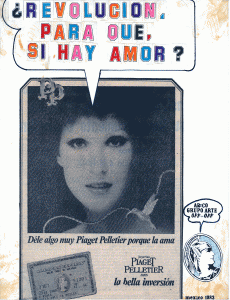« Reviews
Arte Correo

Collective poem Revolución (excerpt), 1982. Colectivo 3. Photo courtesy Museo de la Ciudad de Mexico.
Museo de la Ciudad de México
Curated by Mauricio Marcín
By Lourdes Morales
The “Arte Correo” (Postal Art) exhibition -presented at the Museo de la Ciudad de México- assembles the work of more than two hundred artists, including Maris Bustamante, Ulises Carrión, Mauricio Guerrero, Mathias Goeritz, César Espinosa, Felipe Ehrenberg, Aarón Flores, Pedro Friedeberg, Marcos Kurtycs, Magali Lara, Mónica Mayer, Clemente Padín and Araceli Zúñiga, among many others. The exhibition curator, Mauricio Marcin, uses Poesía Concreta (1953) (Concrete Poetry) as a precise referent for postal art. As principal arbiter of semantic functions, this movement explains their relationship to the two-dimensional space that contains them. Poesía Concreta uses physical and linguistic properties to transcend both the limits and the very means of communication. Marcín proposes an understanding of postal art.
In-depth research has gathered together three decades of stamps, envelopes and postcards - obviously- letters, posters, drawings and photographs, calligrams, collages and stamps and -not so obviously- one of the last vestiges of the movement: the fax. Marcín undertook the task of creating a narrative about joining the archives of artists and institutions, creating an exegesis of the history of postal art and its function as a political force in opposing certain totalitarian regimes. The documents evidence an unofficial collective memory that legitimizes itself as an ethical substrate of political and social events in Latin America from the 1960s through the 1990s. Postal art is presented here as a means of establishing identity and improved forms of culture when faced with demands that Algerian philosopher, Louis Althusser, designated as Ideological State Apparatuses (ISAs). The back-and-forth movement of material across borders, customs and political circumstances (more than fifty countries on five continents), is configured in the exhibition space as proof of the flow and negotiation of collective desire. This curatorship discloses implied space generated by the need for communal networking, and also a specific construction resulting from displacement far beyond the governmental field of vision. For example, “Desaparecidos Políticos de la América Latina” (1984) was a call sounded by Mexican postal artists to produce collective condemnation; it was answered by countless people. This situation manifested the highest degree of artistic interaction outside of any institutional circuit, a perpetual network aware of the work of imagination in confronting profoundly adverse conditions. Without a doubt, another obvious example was the creation in 1977 of Sistema Internacional de Arte Correo Errático (Erratic Art Mail International System - EAMIS) by the artist, Ulises Carrión, who as postal administrator offered the delivery of messages “…in any format -card, letter, package, etc.,” (170) by any means except official mail. A copy of the message was also requested “… to be placed in EAMIS files after delivery of the original.” (170) We should then close this brief analysis by considering the correspondence between postal art and its potential as architecture-archive in the alterity of self-administered memory.
(November 1, 2009 - February 17, 2010)
WORKS CITED
Carrión, Ulises. “Sistema Internacional de Arte Correo erratico. Una alternativa a las Oficinas de Correo Oficiales.” 1977. In: Carrión, Ulises. ¿Mundos personales o estrategias culturales?, Mexico: Dirección General de Publicaciones del Conaculta/Turner Ediciones, 2003.
Lourdes Morales is an independent curator and arts writer based in Mexico City. She is part of LC060 (Laboratorio Curatorial 060), an experimental collective interested in questioning the ideas that define contemporary cultural practices.
Filed Under: Reviews


































